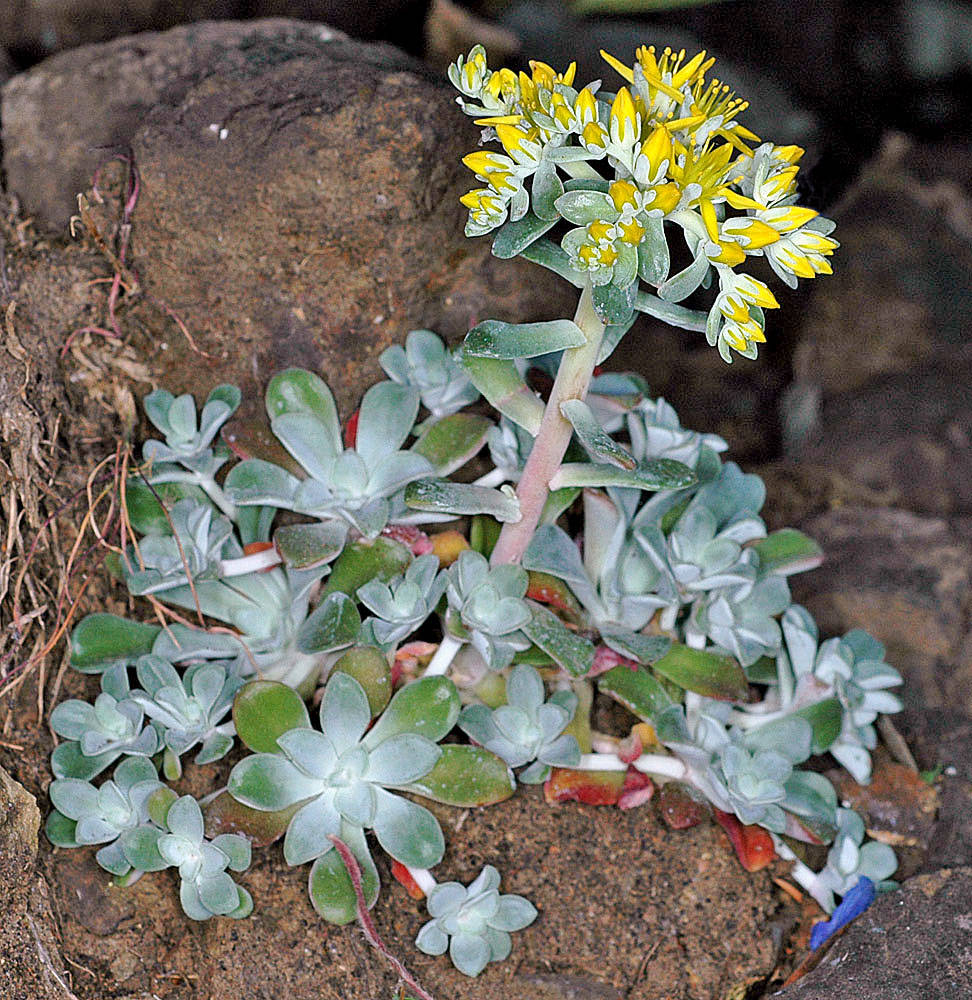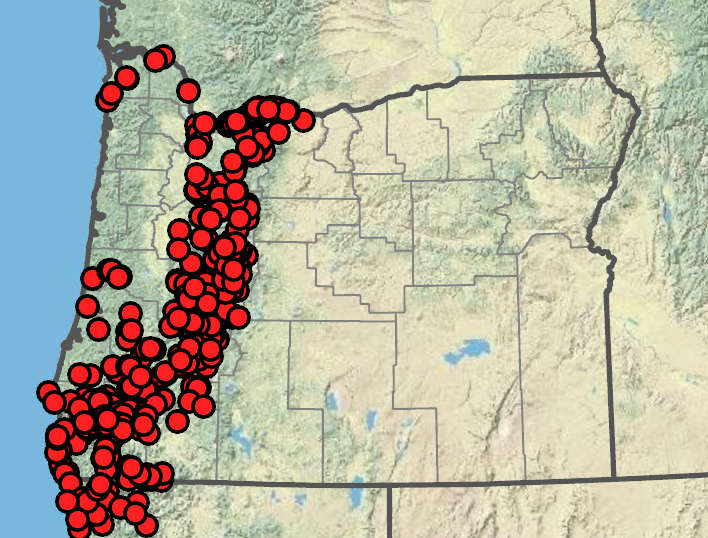Sedum spathulifolium
Sedum
broadleaf stonecrop
stonecrop
extensively stoloniferous, with dense terminal rosettes.
erect to creeping, usually much branched; horizontal stems well developed, green to reddish.
erect; simple, 3–14 cm;
stem leaves alternate, spatulate-oblong or elliptic-oblong; widest at or below middle, different from rosette leaves.
rosette leaves spreading, usually nearly parallel to ground, usually forming flat rosettes, spatulate, narrowing to petioles, 7–19 × 4.5–10 mm, 5 × as wide as thick, green or pruinose and white, bases not spurred, not scarious, sometimes muricate or papillose near margins;
tips rounded or truncate;
surfaces usually glaucous.
alternate or opposite, sometimes forming dense rosettes, succulent, linear to orbicular or spatulate; terete to laminar, 0.1–8 cm, bases spurred or not;
margins entire.
cymes with ~30 flowers, 3-branched;
branches forked;
bracts oblong-spatulate or linear.
terminal or axillary cymes, arising from tip of rosette.
5-parted;
sepals spreading to erect, lanceolate, linear-lanceolate, oblong-ovate or obovate; ~2.5 × 1.5 mm, green to yellow-green;
tips acute or obtuse;
surface glaucous or pruinose;
petals strongly spreading above erect base, linear to oblanceolate, 4.5–9 mm, yellow;
tips acute;
filaments yellow;
anthers yellow.
(4)5(6+)-parted;
sepals distinct or basally connate;
petals erect to spreading at anthesis; distinct or basally connate, yellow, white, pink, or red, often with red midribs or bases;
stamens 2 × as many as sepals, rarely equal;
pistils erect; distinct to basally fused.
erect until mature then spreading, fused basally, brown.
follicles; erect or spreading.
Sedum spathulifolium
Sedum
Rocks, cliffs and road cuts. Flowering Apr–Aug. 0–2400 m. Casc, Col, CR, ECas, Est, Sisk, WV. CA, WA; north to British Columbia. Native.
Sedum spathulifolium is highly variable. If subspecies are recognized, most of our plants are S. spathulifolium ssp. spathulifolium. A coastal form with thick, white-pruinose leaves, short, stout stolons, dense inflorescences and thick, crowded stem leaves can be called S. s. ssp. pruinosum (if it is considered a strictly coastal entity). If it is considered to include strongly glaucous or pruinose plants of the Coast Range that are less dense in growth form, the name S. s. var. minus would be applied. Plants with thin, green leaves, numerous long, slender stolons that tend to grow upwards before growing out, paler flowers, and more spreading follicles can be called S. s. ssp. purdyi, a rare form known only from southern Josephine County, and Del Norte and Siskiyou counties in California.
Africa, Asia, Central America, Europe, North America. ~450 species; 13 species treated in Flora.
Sedum, as defined here, is a diverse group, and not all the members are close relatives. The species now placed in Sedella and Rhodiola have already been removed from Sedum, and the genus may be split further. Recent research using DNA markers indicates that Dudleya arose within Sedum, as it is currently defined. Therefore, either Dudleya will be transferred into Sedum or Sedum will be broken up. Use of the key may require fresh flowers from early in the flowering season or photographs or detailed descriptions of such flowers. “Stem leaves” are those of the flowering stems. Late in the season, stem leaves fall away. The last few flowers of the season of some taxa can be cleistogamous and are atypical in petal length and orientation. Anther color changes with age and may be hidden by yellow pollen.
Barbara Wilson, Richard Brainerd, Nick Otting
Barbara Wilson, Richard Brainerd, Nick Otting
- Local floras:
BC,
CA,
OR,
WA
- Local Web sites:
CalFlora,
CalPhotos,
Flora NW,
PNW Herbaria,
Turner Photog.
WildflowerSearch
iNaturalist (observations)
USDA Plants Database
- LBJ Wildflower Center
- SEINet
- Plants of the World Online
- Encyclopedia of Life
- Wikipedia
- Google Image Search




